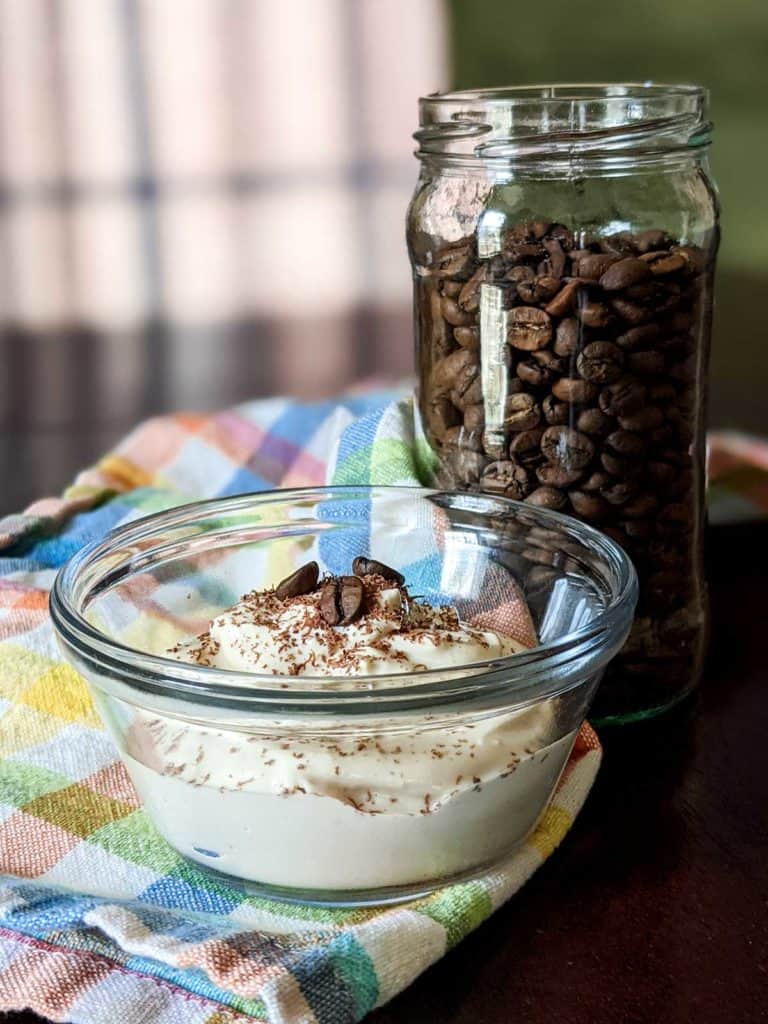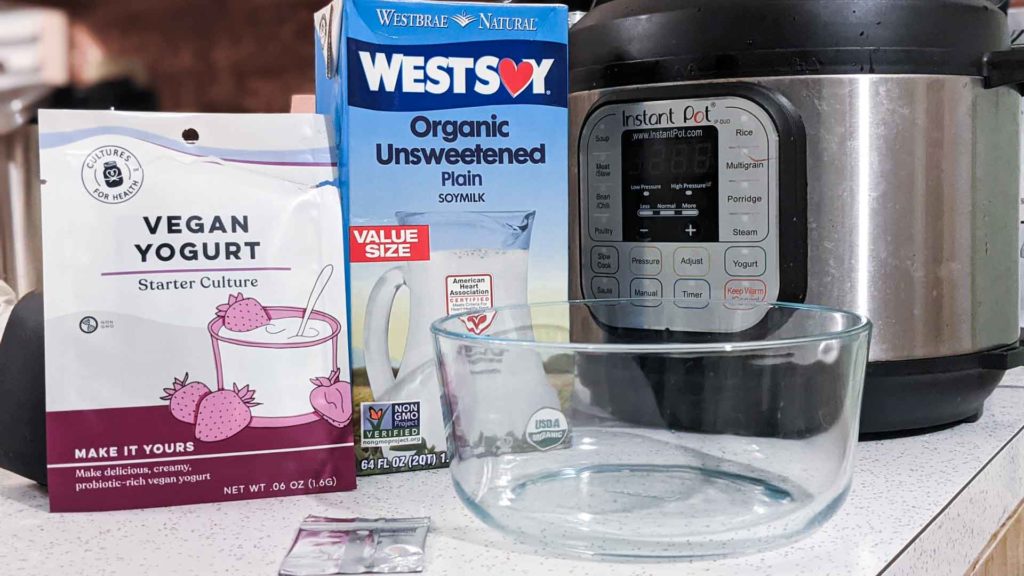There have been huge advances in the last few years in the variety of vegan cheeses and other dairy alternatives that are commercially available. But in my experience, the vegan yogurt section of the refrigerated aisle has always been a few square feet of disappointment.
I’m not sure why the commercially available options — even the ones from brands that make other products that I do like — are so inadequate. Maybe it’s the added sweeteners, preservatives, or thickening agents in the formulas. But whatever the problem is, it makes for cloyingly sweet, texturally off-putting imitations of yogurt.
Fortunately, my trusty Instant Pot makes it easy to culture a tangy, rich soy yogurt at home. All you need is soy milk, a starter, warmth, and time.

🥄 About this recipe
It took me several attempts to make a successful batch of yogurt. The first time I tried, the starter was defective. The second time, I didn’t culture it long enough and ended up with a bland, watery mess.
And then there was the time that I made the yogurt directly in the stainless steel bowl of the instant pot, and it took on the onion and cumin aromas that were lingering from the black bean soup I’d previously made.
Today, I can confidently tell you that I have this process down. And the yogurt is so good that friends have been asking me to start selling it locally.
The best thing about making homemade yogurt, though, is that it’s not just good for accompanying granola. I can also use it in a variety of recipes, from vegan paprikash to palak paneer.
Try it in my Steakhouse-Style Vegan Creamed Spinach, or as a base for Granola with Mangos and Almonds and Black Sesame Granola.
✔️ Ingredients

You can go wild with sweeteners and flavorings after you’ve made your yogurt, but to get started, you only need two ingredients.
Soy milk
You’ll need unsweetened soy milk that doesn’t have any ingredients other than soybeans and water. That means that you’ll need to skip the products in the refrigerated section of the supermarket.
Instead, look for the shelf-stable aseptic packages of non-dairy milk. It’s often stocked near the cereal or in the non-refrigerated aisle that contains juices and other beverages.
Most well-stocked stores carry my favorite — Westsoy’s unsweetened organic soy milk — and I’ve also had good experiences with Trader Joe’s brand soy milk. The important thing is to check the list of ingredients and make sure that there aren’t any additives. Any added sugars, preservatives, or stabilizers will result in a bad batch of yogurt.
Starter culture
My favorite starter culture is made by Cultures for Health. They have a product that is specifically made for vegan yogurt, and I’ve had solid results with it. That is, I’ve had solid results since I figured out that I prefer to culture the yogurt for a much longer period of time than is indicated in their instructions!
There are other brands on the market as well, so you can shop around and choose one that sounds good to you. My main suggestion is to buy directly from the supplier to make sure that you’re getting the freshest product you can get, and store it in the refrigerator to extend its shelf life.
Some people like to use probiotic capsules to culture their soy yogurt. I haven’t tried this, but this method has enough fans that there must be something to it.
✏️ Instructions
First, make sure any utensils and bowls you will be using are very, very clean.
Then, combine the soy milk and starter culture. I usually just open the container of soy milk and pour the starter directly into the aseptic package, close the lid, and give it a few shakes.
From there, I pour the soy milk into jars or bowls and cover them with their lids or with plastic wrap. (This keeps the yogurt from picking up any undesirable cooking flavors or aromas from the Instant Pot.)
Place the containers into the Instant Pot and close the lid. Set it for 12 – 14 hours on the “Yogurt” setting.
When the time is up, transfer your soy yogurt into the refrigerator and let it chill for at least six hours. Then, just stir the yogurt (or shake it vigorously in a sealed jar) before serving.
Tips for making Greek-style yogurt
When you follow the instructions above, you will end up with yogurt that is tangy and noticeably thicker than soymilk. I think it’s a perfect companion for granola or muesli.
If you prefer your yogurt on the thick side, though, you can strain it after you culture it. For years, I strained my yogurt using a colander balanced in a larger mixing bowl, lined with clean paper towels and covered with a plate on top to serve as a lid. Then, I placed the yogurt in the refrigerator to let it come to my preferred consistency.
There is nothing really wrong with that method, especially if you are just trying to figure out whether you want to get into this whole yogurt-making thing. I did it this way for years.
Recently, though, I received a yogurt strainer as a gift. This thing is a beast, and it will strain a gallon of yogurt at a time. It works really well, and because it has a proper lid, it doesn’t make my whole fridge smell like yogurt.
After you strain the yogurt, you can either discard the liquid that you’ve removed, or you can keep it to use in other ways. I use it to replace the water in some bread recipes or to give vegan “cheese” a more dairy-like taste. You can also add it to smoothies, use it to soak beans and grains, or add it to your garden compost.
🧰 What you’ll need
Note: This section contains affiliate links. I may earn a small commission if you follow the links and make a purchase. This doesn’t cost you anything, and it helps me continue running Bittertreats.
- An Instant Pot with a setting for yogurt (or another method of keeping the yogurt at a controlled temperature for many hours while it cultures)
- One or more containers that fit into your Instant Pot — I prefer to use mason jars or Pyrex bowls with lids
- A starter culture — I use the Vegan Yogurt Starter from Cultures for Health; it is formulated specifically for making yogurt from plant-based milks
- A type of soy milk that doesn’t contain any sweeteners or additives — be sure to check the label! I use Westsoy Organic Unsweetened Plain Soymilk because its only ingredients are soybeans and water. That means that there are no additives to get in the way of the starter culture. It’s also sold in aseptic packaging, so the soymilk is already sterile.
- A yogurt strainer (optional, for Greek-style yogurt). Since I make large batches, I love this 1 gallon strainer from Hatrigo.
📖 Recipe

Instant Pot Soy Yogurt
This creamy, tangy soy yogurt is great with fruit, granola, or as an ingredient in a variety of other recipes.
Ingredients
- Shelf-stable, organic, unsweetened soy milk. Starter culture works with a range of 32 - 64 ounces of soy milk (see notes).
- 1 packet vegan soy yogurt starter culture
Instructions
Culture the yogurt
- Make sure any utensils and bowls you will be using are very, very clean
- Combine soy milk and starter culture
- Pour into jars or bowl; cover
- Place into the Instant Pot and close the lid
- Set the Instant Pot for 14 hours on the "Yogurt" setting
- When the time is up, transfer the yogurt into the refrigerator and let it set for about six hours
- OPTIONAL, for Greek-style yogurt: Before you put the yogurt into the fridge, transfer it into a strainer or similar setup. Then refrigerate for at least 6 hours, or until the yogurt reaches the desired consistency.
- ALSO OPTIONAL, for ultra-creamy Greek-style yogurt: After you strain the yogurt, transfer it into a bowl and use an immersion blender to whip the yogurt until it is smooth.
Notes
Each Cultures for Health starter packet will culture up to 64 ounces of soymilk. In my household, we consume a lot of yogurt, and I strain much of the liquid, which reduces the total volume of the finished yogurt. So, I typically make 64 ounces at a time. It will work just as well if you use a 32-ounce package of soymilk, though.
How to choose your soymilk: Westsoy is my go-to, and Trader Joe's brand organic soymilk has also worked well for me. You could even make your own! The important thing is that you choose a variety of soymilk that only contains two ingredients: soybeans and water. Any other sweeteners or additives will cause off flavors or prevent the yogurt from culturing properly.
If you prefer a less-tangy yogurt, try culturing for 10-12 hours instead of 14.
Storing soy yogurt: refrigerating the yogurt slows fermentation, but it doesn't completely stop it. I find that after about two weeks, my yogurt is past its prime. It tends to become more bitter and tangy, and the texture changes in ways that I don't like. I rarely see mold or other signs of spoilage, but it does happen. If you see mold on your yogurt, it's time to discard it.
Recommended Products
This section contains affiliate links. If you click on one of the items below and choose to make a purchase, I may make a small commission. This does not cost you anything, and it helps me to maintain Bittertreats.
Nutrition Information
Serving Size 1 cupAmount Per Serving Calories 100Total Fat 5gSaturated Fat 1gCholesterol 0mgSodium 35mgCarbohydrates 4gFiber 1gSugar 3gProtein 9g
Nutrition information is an estimate, and is based on unstrained yogurt. If you make Greek-style yogurt, these values may vary significantly, depending on how much liquid you remove from the yogurt.





Denise Hillel Galt says
Hi Meg,
I’m writing because I was reading on your website about your Insta pot yogurt making and it sounds like you make it pretty regularly and I also make it regularly but suddenly mine is coming out really watery and I’m wondering if you’re having the same experience. I have always used West soy plain soy milk for this and that has not changed and I use the same probiotic that I’ve always used.
It used to be significantly thicker.
Thank you in advance.
Sincerely,
Denise
Meg Kramer says
Hi Denise, I’m sorry to hear that your yogurt has been watery! I haven’t had any trouble with mine lately, so I don’t think the Westsoy milk is the culprit.
I know that it can get expensive (and frustrating) to experiment when the yogurt isn’t turning out well, but maybe a fresh package of the probiotic that you like to use would solve the problem? I’ve had bad packages of starter culture before, and I suspect that they were damaged by heat during shipping in the summertime.
It sounds like you’ve had more than one batch of yogurt turn out watery, so that makes me think it’s probably something to do with the probiotic instead of a one-time thing like contamination from a container or spoon or something like that.
Denise Hillel Galt says
Thank you Meg. I’ll try again and check on my inoculation product. I use both a powder probiotic and yogurt for starter.